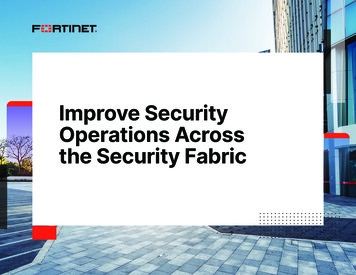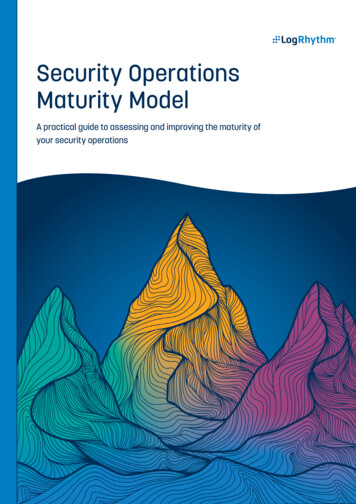
Transcription
Improve SecurityOperations Acrossthe Security Fabric
Table of ContentsExecutive Summary3Simplifying Security Automation Across the Security Fabric5Level 1: Achieve Visibility and Identify True Threats7Level 2: Maximize Multivendor Visibility With SIEM10Level 3: Automate Response With SOAR11Address Complexity with the SOC Automation Model122
Executive SummaryDuring 2020, it was reported that 65% of companies currently lack the skilled staff they need to maintain effectivesecurity operations.1 Many organizations’ security teams are struggling to keep up with operational complexitiessuch as too many consoles and alert overload. And these problems are worsened by layers of manual processes.The impact of COVID-19 has presented new challenges and 76% of organizations indicated that remote workwould increase the time to identify and contain a potential data breach.2The Security Operations Center (SOC) Automation Model is designed to help security teams identify appropriateFortinet security products for their SOC, based on their existing investment in people and processes. Fortinetoffers a range of components to improve the efficiency of security teams at each stage of a SOC’s maturity.Because of differing staffing levels and organizational structures, SOCs at each level of maturity have distinctrequirements. Using the SOC Automation Model, SOC teams can determine the solutions they need to maximizetheir ability to protect the organization.3
Simplifying Security Automation Across the Security FabricOperational complexity is a challenge for security teams of any size. The SOC Automation Model helps anorganization’s security team to identify their current maturity level and choose the Fortinet security solutionsthat are the most appropriate for their environment. The SOC Automation Model is broken up into three keyareas: people, processes, and products. Within each area, an organization can be classified at a maturitylevel 1–3 based upon their security posture. For example, an organization that is level 1 in all categories has asmall IT team with no security staff (people). They have limited incident response playbooks (processes) andno dedicated security solutions (products). At the other extreme, an organization may have a large securityteam with experienced SOC analysts, well-defined playbooks, and have not only deployed but also measurethe effectiveness of their security information and event management (SIEM) and security orchestration,automation, and response (SOAR) solutions.4
Figure 1. SOC automation maturity levels.With a cybersecurity skills gap that is estimated at 3.5 million cybersecurity jobs unfilled in 2021 and growing,improving the people component of an organization’s SOC automation maturity may not be feasible.3 However,by implementing the correct processes and selecting the right products, an organization may be able tocompensate for an understaffed security team.5
The averageenterprise receives5,000 alerts per day.46
Level 1: Achieve Visibility and Identify True ThreatsAt level 1 of the SOC Automation Model, a security team has no dedicated security personnel or processes foraddressing potential incidents. At this level, SOC analysts are overwhelmed and have little time for identifyingand remediating true threats to the network. Without dedicated solutions, an organization’s security team lacksvisibility into potential threats to their network. All of the log data must be manually collected and correlatedbefore any analysis can be performed. Many level 1 SOC staff lack the knowledge or the resources to identifytrue threats, which puts the organization at risk.Security Fabric AnalyticsFortiAnalyzer is an easy-to-deploy solution for centralizing visibility and threat detection across anorganization’s entire Fortinet Security Fabric, including both on-premises and cloud deployments. FortiAnalyzercorrelates log data from multiple Fortinet devices, which provides valuable context to security analysts. Byanalyzing this data using machine learning (ML) and indicators of compromise (IOCs) provided through a globalthreat-intelligence feed, FortiAnalyzer can help even the smallest security team to pinpoint and rapidly respondto threats within their network. Smaller teams also can accelerate their maturity with the FortiSOAR container,which supplies a version of SOAR within FortiAnalyzer.7
Extended Detection and ResponseMany organizations are concerned about the dynamic cyber threat landscape, but are constrained by limitedstaff and processes. Their small, multifunction teams need to be selective about the products they have withintheir technology stack. As the first artificial intelligence (AI)-based extended detection and response (XDR)solution, FortiXDR extends the SOC Automation level 1 foundation. It enables automated incident detection,investigation, and response across the Fortinet Security Fabric.Designed for a consolidated approach using existing technologies in the Fortinet Security Fabric, FortiXDRapplies curated analytics to FortiAnalyzer, which converts raw alerts into high-fidelity incident detections. Ituses AI to automatically investigate those incidents and provides a simplified framework to predefine commonresponse actions. In doing so, it enables a more hands-off approach for overstretched teams that lack the timeor expertise to keep up with threat and alert volume.8
The average time toidentify and contain abreach is 280 days.59
Level 2: Maximize Multivendor Visibility With SIEMAs new threats evolve, to counter the sophistication of attackers, organizations deploy a multitude oftechnologies. This type of multivendor infrastructure often lacks visibility among the products within the securitystack. Although each of the solutions may provide valuable intelligence about potential network threats, theyoften lack the context needed to differentiate between a true threat and a false positive. Additionally, an array ofstandalone security solutions makes it difficult to enforce consistent security policies and maintain compliancewith data protection regulations, such as the European Union’s General Data Protection Regulation (GDPR) or theCalifornia Consumer Privacy Act (CCPA).A SIEM system is the logical solution to the security complexity caused by a multivendor environment. A SIEMsolution ingests data collected from products created by multiple different vendors and performs automatedcorrelation and analysis to provide a clearer picture of the overall status of the protected environment.FortiSIEM allows security teams to map operations to industry best practices and security standards, such asthose published by the Center for Internet Security (CIS). In this way, FortiSIEM expands on the visibility thatFortiAnalyzer brings to the Fortinet Security Fabric.10
Level 3: Automate Response With SOARTo accelerate and expand the reach of their attacks, cyber criminals have been shifting their focus to includeautomation. Although extensive visibility into the network can help detect potential threats, the response tothese threats can be fragmented because of lengthy manual workflows. Without the benefit of advanced securityprocesses, security teams are often operating at a disadvantage, which increases an organization’s risk. But withSOAR solutions, an organization’s security team can speed incident response through automation.Building on the capabilities of FortiAnalyzer and FortiSIEM, FortiSOAR is located at the peak of the SOCAutomation Model. By creating an advanced automated framework coupled with comprehensive casemanagement, an organization can pull together their complete security architecture. During a response, teamsare enabled to respond cohesively and collaboratively with infrastructure security tools. As a result, securityoperators can accelerate incident response, decrease alert fatigue, and minimize the potential for overlooking vitalinformation that could be hidden in the volume of alerts. FortiSOAR helps optimize security processes throughwell-defined security playbooks that automate repetitive tasks and responses to frequent threats. With FortiSOAR,security teams can become proactive, instead of reactive, giving analysts more time for more critical tasks.11
Figure 2. Best practice compliance.Address Complexity With the SOC Automation ModelThe cybersecurity threat landscape is quickly evolving, yet many organizations are not able to adapt at the rateit’s growing. They may face operational complexities and limited resources and skilled personnel. To keep up withaccelerating cyber threats, organizations need security solutions that help shift the cybersecurity workload off ofoverburdened and understaffed security teams. The SOC Automation Model helps security architects determinetheir current level of maturity and the steps that they must take to reach the next level.Fortinet solutions, such as FortiAnalyzer, FortiXDR, FortiSIEM, and FortiSOAR, are designed to simplify thetransition to each level. By using intelligent security automation, these tools not only reduce mean time todetection (MTTD) and mean time to response (MTTR) but they also decrease an organization’s exposure to cyberthreats and improve operational efficiency.12
1“2020 Cost of a Data Breach Report,” IBM, 2020.2Ibid.3Steve Morgan, “Cybersecurity Talent Crunch To Create 3.5 Million Unfilled Jobs Globally By 2021,” Cybercrime Magazine, October 24, 2019.4“Cisco 2020 CISO Benchmark Report,” Cisco, 2020.5“2020 Cost of a Data Breach Report,” IBM, 2020.www.fortinet.comCopyright 2021 Fortinet, Inc. All rights reserved. Fortinet , FortiGate , FortiCare and FortiGuard , and certain other marks are registered trademarks of Fortinet, Inc., and other Fortinet names herein may also be registered and/or common law trademarks of Fortinet. All other product or companynames may be trademarks of their respective owners. Performance and other metrics contained herein were attained in internal lab tests under ideal conditions, and actual performance and other results may vary. Network variables, different network environments and other conditions may affectperformance results. Nothing herein represents any binding commitment by Fortinet, and Fortinet disclaims all warranties, whether express or implied, except to the extent Fortinet enters a binding written contract, signed by Fortinet’s General Counsel, with a purchaser that expressly warrantsthat the identified product will perform according to certain expressly-identified performance metrics and, in such event, only the specific performance metrics expressly identified in such binding written contract shall be binding on Fortinet. For absolute clarity, any such warranty will be limited toperformance in the same ideal conditions as in Fortinet’s internal lab tests. Fortinet disclaims in full any covenants, representations, and guarantees pursuant hereto, whether express or implied. Fortinet reserves the right to change, modify, transfer, or otherwise revise this publication without notice,and the most current version of the publication shall be applicable.May 3, 2021 12:04 AMebook-soc-automation972314-0-0-EN
Security Fabric Analytics FortiAnalyzer is an easy-to-deploy solution for centralizing visibility and threat detection across an organization's entire Fortinet Security Fabric, including both on-premises and cloud deployments. FortiAnalyzer correlates log data from multiple Fortinet devices, which provides valuable context to security .










